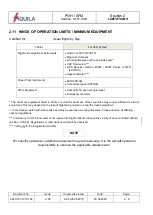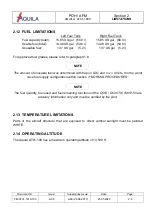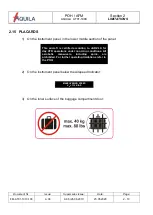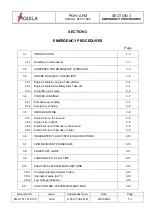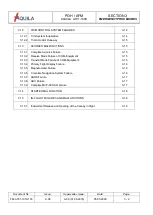
POH / AFM
AQUILA AT01-100C
SECTION 3
EMERGENCY PROCEDURES
Document Nr.:
Issue:
Supersedes Issue:
Date:
Page:
FM-AT01-1010-103
A.08
A.06 (01.06.2018)
25.05.2020
3 - 11
3.8 POWER-OFF GLIDE
Achievable gliding distances vary depending on altitude and current wind conditions. This is
very important when choosing a landing site or reaching a near-by airfield.
To achieve maximum gliding distance:
1.
Flaps
UP
2.
Airspeed
78 KIAS
3.
Demonstrated glide ratio
14
This means approx. 2.3 NM can
be covered for every 1000 ft of
altitude (no wind)
NOTE
Headwinds, tailwinds and wing contamination can significantly influence the distance
achievable in glide.
3.9 LANDING WITH A FLAT TIRE
When landing with a defective tire, or this is suspected, proceed as follows:
1.
Flaps
LDG position
2.
Perform touch down on the side of the runway opposite the defective tire. This allows
the use of the entire runway width to correct any directional changes
caused by the
defective tire. (for example: left tire defective, land on the right
side of the runway)
3.
Perform touch down with the undamaged main tire first. Lower nose wheel as quickly
as possible to improve controllability on the ground.
4.
Roll out with full aileron deflection in the direction of the undamaged main tire. This
reduces the load on the damaged tire.
5.
When landing with a defective or damaged nose wheel:
Touch down with minimum speed.
Keep nose wheel off the ground
as long as possible.


